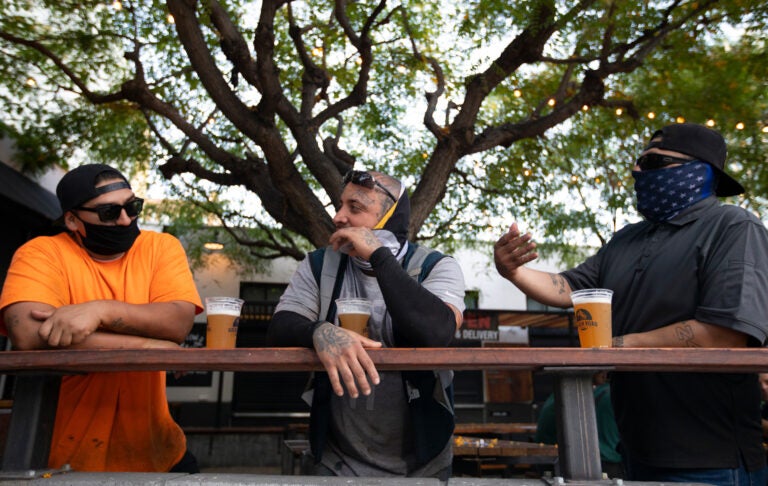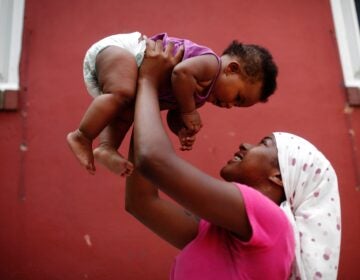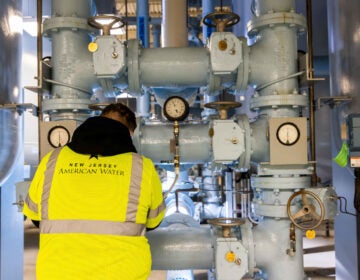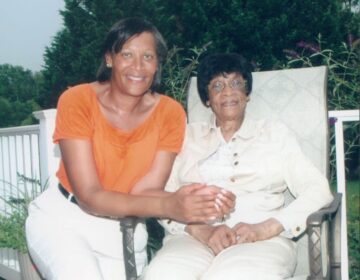Planning to celebrate the 4th? What to know about the risks of parties and bars

With new coronavirus infections climbing in most states, infectious disease experts are discouraging group get-togethers, especially those that involve drinking. In this photo patrons enjoy a beer outside the Central Market in Los Angeles, this week. (Francine Orr/Los Angeles Times via Getty Images)
Wanting to get together with friends and family to celebrate this holiday weekend but nervous about the coronavirus?
With new infections climbing in most states, infectious disease experts discourage group get-togethers, especially one that involves drinking. Bottom line: Watch out for parties or bars.
These settings tend to lead to a breakdown of the very behaviors that help prevent new infections. It’s a dangerous mix: socializing in large groups, sometimes in tight spaces and drinking, which lowers inhibitions and makes it less likely they’ll follow pandemic precautions like wearing masks and practicing good hygiene. Plus party-goers end up talking loudly, which only increases the chance of spraying virus-laden particles on other guests, especially indoors.
“It’s really hard to wear a mask in a bar. It’s hard to stay six feet apart. It’s hard to constantly wash your hands and not touch surfaces other people have touched,” says Dr. Thomas Tsai, a professor at Harvard University’s T. H. Chan School of Public Health.
If you or those you live with are high risk, or you live in a place with a lot of community spread right now (look up your state or county here), it’s probably best to sit out any situation where you will be drinking in a group. If you are planning to go out — or to host a shindig — read on for advice to stay safe.
To understand how serious the risks of large alcohol-based gatherings are, consider the case of Harper’s Restaurant and Brewpub in East Lansing, Mich. This popular college student hangout spot was linked to more than 150 coronavirus cases from exposure between June 12 and 20.
Ingham County Health Officer Linda Vail says she was first tipped off to the outbreak when two people who had gone to the pub on different days tested positive. When her staff showed up to inspect the bar, it appeared that public health guidance was being followed. The tables were six feet apart. The staff were wearing masks. But Vail says social media told a different story.
“There were pictures of giant crowded lines outside and videos of indoors where people were standing up packed together, out on the dance floor,” Vail says. “It tends to be a place where people just get up and walk around, crowd together, dance, all those sorts of things.”
The facility soon shut down.
Similar stories are popping up all over the country. Recently, states like Arizona, Texas and Florida have shut down bars, clubs and other venues out of concern they were contributing to a surge in cases.
Tsai and his colleagues have studied the effect of lock down restrictions in different states using Google mobility data. One of their conclusions was that “limits on bars and restaurants appeared to be the single most effective social distancing order.”
But people want to socialize, especially on a long summer weekend. While there are no guarantees, public health experts say there are some general principles and specific precautions that can guide any group gathering. Think of each measure as one more layer of protection that can minimize your risk of catching the virus.
Stay outside, but don’t let that make you cavalier
First, a backyard barbecue is much better than a crowded indoor party.
“Outside activities, you are definitely safer than inside activities,” says Dr. Nate Smith, president of the Association of State and Territorial Health Officials. “There are a lot of things that can be done outdoors safely.”
Research shows the chance of catching the virus goes down significantly when you’re outdoors.
“You get better dilution with air movement in the outdoors. Sunlight is a good inactivator of the virus,” says Scott Meschke, a professor of Environmental and Occupational Health Sciences at the University of Washington.
But that still doesn’t mean you should forego precautions like wearing masks and social distancing.
“If people are outdoors and congregating together, without masks right next to each other, shoulder to shoulder, then they are still at risk,” says Dr. Rachel Levine, Pennsylvania’s health secretary.
Monitor your personal air space
Speaking generates a cloud of tiny particles that can reach another person if you are near each other, especially if someone isn’t wearing a mask.
“If we’re close together, you’re inhaling a very concentrated cloud. And in that situation, I think you’re getting a pretty significant dose in your respiratory system,” says Dr. Richard Corsi, Dean of Maseeh College of Engineering & Computer Science at Portland State University.
Scientists don’t yet understand what “dose” of the virus leads to someone becoming infected and then developing COVID-19. That depends on a variety of factors like the amount of time you spend in a space with the virus, the concentration of infectious virus in the air and how heavily you are breathing, among other things.
“I think the most prudent thing to do at this point is just lower your dose as much as possible,” says Corsi.
Indoors? Pay attention to ventilation
Indoor gatherings pose a higher risk because it’s generally harder to avoid close interactions, and there isn’t as much air flow, either.
Spaces without good ventilation can have tiny aerosolized particles hanging in the room and possibly infecting people. Corsi says it’s not yet clear exactly how much of a role this plays in spreading infection, but there’s growing evidence it can be significant.
So what does all this mean for hanging out inside?
Corsi says the best approach is to “make the indoor environment more like the outdoor environment where we know the transmission is much lower.”
That means keeping the room well ventilated and regularly refilled with an outdoor supply of air. If nothing else, open the windows and turn on fans. Avoid places that are poorly ventilated where the air seems stagnant.
And, of course, always wear your mask.
Think small and exclusive
During the pandemic, the best kind of party to host or to attend is for VIPs only. “Keep the occupancy numbers low enough so people are not on top of each other,” says Meschke.
Meschke advises limiting gatherings to close contacts who you know are being careful, and focus on what you can personally control, like maintaining distance from others and minimizing your time in confined spaces.
“If people are drinking, people are going to lose track of things,” says Meschke. Important things, like getting way too up close and personal, talking too loud, neglecting a mask or touching your face.
This is not a good moment to expand your social bubble or let your guard down. “There is no threshold here,” says Meschke. “Right place. Right time. Right host. And you can get infected.”
How do you wear a mask while drinking?
Experts (and common sense) agree: It’s difficult to wear a mask while you’re drinking and eating.
“Of course, you’ll have to pull your mask down,” says Dr. Rachel Levine.
Levine says do your best to leave room around yourself while you’re consuming your beverages or barbeque. Then mask up, again.
“When people are not actively eating and drinking, make sure they’re wearing their masks and that there is social distancing as much as possible,” Levine says.
Keep the noise down
Even outdoors, try to avoid situations where people are shouting. If you’re the host, keep any music low, to limit the need for people to shout over background noise. Shouting or even talking loudly at close range can lead to more droplets being expelled. And no sing-alongs or karaoke. Singing can be a particularly potent way of spreading small droplets that contain the virus.
If you’re at a gathering where the noise levels are rising and you start to notice people shouting, it’s probably time to call it a night.
Have plenty of alcohol — the kind for your hands
If you’re hosting, stock up on the sanitizer, suggests Meschke. “Make handwashing or hand scrubs readily available, keep squirt bottles on every table,” he says.
If you’re going out, put a mini-bottle in your purse and use it often, whenever you touch shared surfaces, and especially after using the bathroom.
BYO-Everything
This is not the year to have a gorgeous spread of finger food for your guests. “I would urge people to not share food or drinks with others outside of your household,” said infectious disease specialist Dr. Joshua Barocas, at a recent briefing by the Infectious Diseases Society of America. This includes food, utensils, bottles of rum, pitchers of punch, you name it.
So bring your own goodies, or eat before you go. And beyond that, come stocked with your own sunscreen, bug spray and wipes and drinking water. “Avoid sharing items. Anything that you can do to limit your physical interactions with others will help reduce the spread,” says Barocas.
Bathrooms beware
Be particularly careful of bathrooms.
First, people tend to crowd outside while waiting for their turn. Once inside, take caution not to touch lots of surfaces, which would have been contaminated. Always wash hands carefully when you’re finished. If you can, don’t hang out too long in the bathroom. New research shows that flushing a toilet can release lingering clouds of coronavirus particles found in fecal matter into the air. It’s unclear whether you can actually get infected this way. Wear a mask, just to be safe.
9(MDAzMzI1ODY3MDEyMzkzOTE3NjIxNDg3MQ001))




